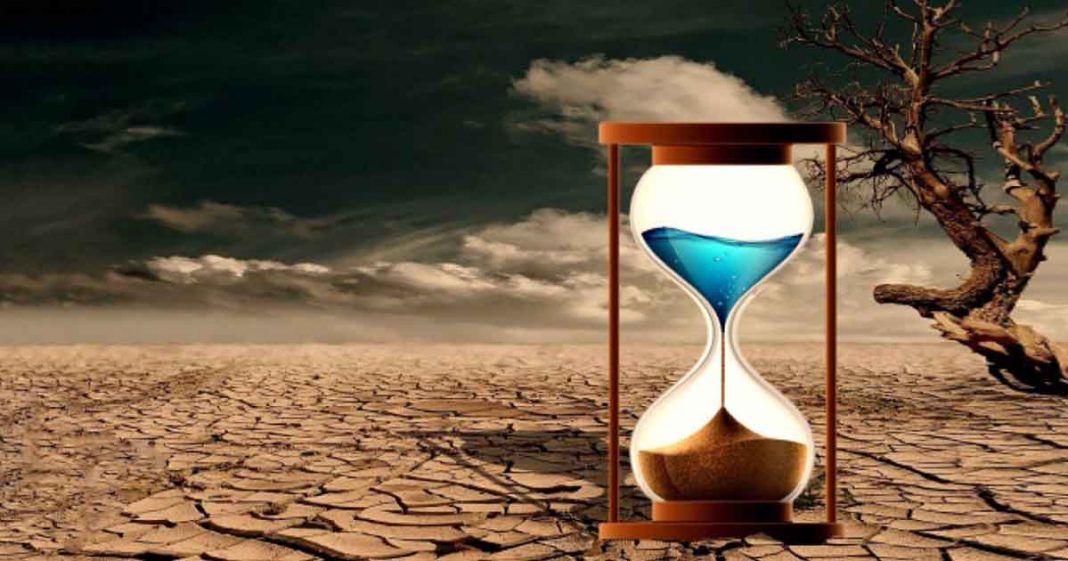22 March 2021 is observed by the UN as a World Water Day so as to highlight the importance of freshwater in our lives. Water security is usually explained as the sustainable availability of drinkable and usable water to every individual. Unfortunately, Pakistan is “in the list of top 33 countries under extreme water stress”, with Karachi being the sixth highly water insecure metropolitan on the globe and forecasts paint an even direr picture indicating that Pakistan will face a severe water shortage by 2025.
Though South Asia (SA) has only four percent of the global land area, it nourishes around 21 percent (1.7 billion) of the total world population. Unfortunately, the region is also one of the most climate-change (CC) affected zones of the globe.
While there is expanding the understanding that climate change could exacerbate the existing water shortage in Pakistan, its vulnerability rests in how much this may happen and its potential ramifications.
According to the Climate Change Profile of Pakistan 2017, “Pakistan does not have an extensive assessment of how changing climatic conditions are or could unfavorably influence its water assets and effective strategy to reduce ramifications. “Karachi is the sixth most vulnerable city to water insecurity globally, and Pakistan is in “the top 33 countries under extreme water stress.”
Read More: Water Wars – A battle for Pakistan
Moreover, Pakistan will face an acute water shortage by 2025 if the existing pattern continues. While population and demand for water are relentlessly increasing, both the amount of freshwater and its quality are diminishing and, one of Pakistan’s most significant water challenges is that none of its freshwater sources is inside its boundaries.
Pakistan depends on the Indus River’s five tributaries, which originates from Tibet (disputed between India and China) and passes through high lands of Illegally Indian occupied Jammu and Kashmir before reaching mainland Pakistan.
The environmental change represents extra dangers as temperature rise brings a shift in precipitation designs, surges, and dry spells, which turn out to be more extreme. In 2010, Pakistan experienced extreme floods, influencing around 20 million individuals and causing US$ 5 billion losses in horticulture alone. The year 2012 likewise observed flooding, affecting another 4.8 million individuals and obliterating crops.
Read More: Alarming Water Situation for Pakistan & No Light at End of the Tunnel
Global Catastrophic Risk Institute in its annual report for 2020 placed Pakistan on the fifth spot on the list of countries most vulnerable to climate change. According to the report, ‘Pakistan lost 9,989 lives, suffered economic losses worth $3.8 billion and witnessed 152 extreme weather events from 1999 to 2018’ and based on this data, the think-tank has concluded that Pakistan’s vulnerability to climate change is increasing.
Defining Water Security
According to United Nations Water (UN-Water), water security can be defined as “the capacity of a population to safeguard sustainable access to adequate quantities of acceptable quality water for sustaining livelihoods, human well-being, and socio-economic development for ensuring protection against water-borne pollution and water-related disasters, and for preserving ecosystems in a climate of peace and political stability.”
Similarly, according to Global Water Partnership (GWP), water security is a condition when “every person has access to enough safe water at an affordable cost to lead a clean, healthy and productive life while ensuring the environment is protected and enhanced.”
Water security, in this manner, is usually explained as the sustainable availability of drinkable and usable water to every individual of an area, making it a key target in UN Sustainable Development Goals (SDGs) as the “availability and sustainable management of water and sanitation for all (SDG-6).”
Read More: Azad Kashmir: Bringing Water, Power & Beauty to Pakistan & CPEC
Water isn’t just embedded in the SDG- 6 target, but its importance runs through several of the targets indirectly, including those concentrated on health (SDG-3), human settlements (SDG-11), sustainable consumption, and production (SDG-12), and ecosystems (SDG-15).
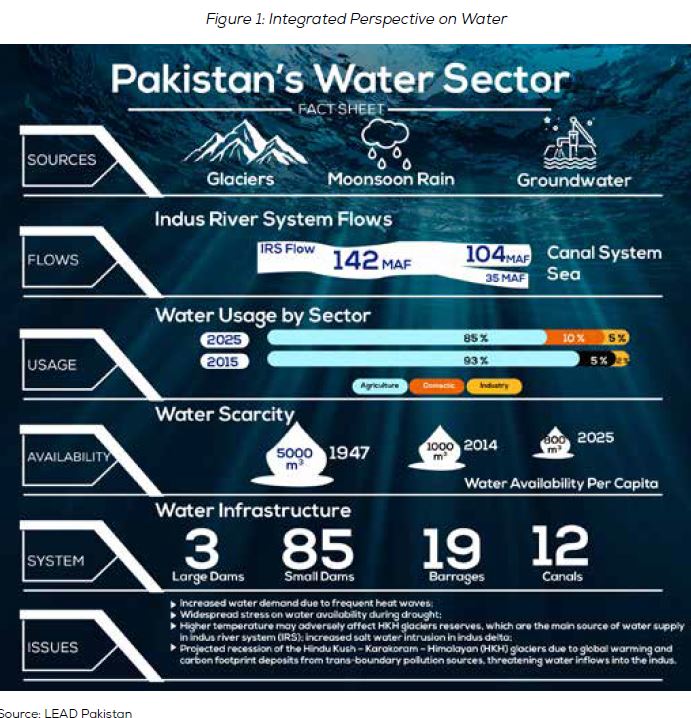
In Pakistan’s case, unfortunately, water issues are not only limited to simply sustainable access to water resource but also includes trans-boundary water-related problems, such as integrated water resource management, ecosystem management, and water-use practices on both sides of the border.
Conflicting interpretations of the Indus Water Treaty (IWT) clauses provided India with the opportunity to build water reservoirs and control structures on the rivers allocated to Pakistan under the treaty that have subsequently become of critical concern to Pakistan’s water security.
Read More: Will ‘Safe Water’ lead Pakistan’s Fight against COVID-19?
Besides the loopholes in the dispute resolution mechanism of IWT, it also does not expedite collaboration pertaining to Climate Change, augment water demand, or look at any other sustainable development issues.
Indus Basin’s Hydrological Assessment
According to scores of research work, glaciers contribute around 25- 32 percent of water in the Indus Rivers. However, topographical as well as climate change constraints result in differentiated flow patterns across the basin’s tributaries.
Hydrological factors of the Indus basin are usually affected by changing temperature and precipitation patterns and flow rates are directly proportional to the temperature level, as higher temperature leads to rapid melting of glaciers resulting in greater volume and faster river flow.
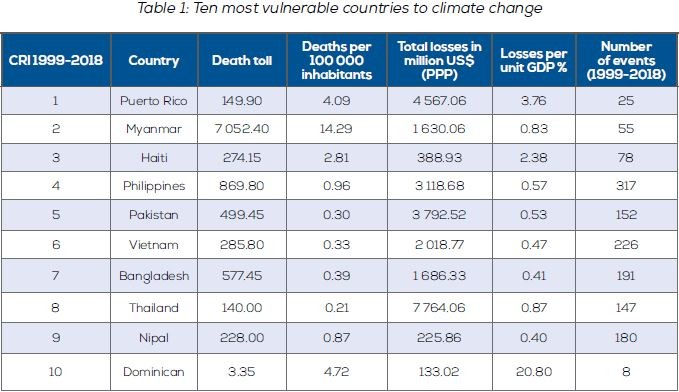
As far as the contribution of snow melting in the Indus Waters is concerned, it constitutes almost 35-40 percent of water. Rainfall is the chief contributor to the Indus Rivers but often causes lowland flooding, resulting in the intense runoff.
Current Situation of Water in Pakistan
The current water availability in Pakistan is quite erratic, mainly because of climate change and population growth both creating risks to the overall water availability.
Due to rapid urbanization along with increasing population growing at over 2% per annum, water demand is also increasing, pushing the country to severe water scarcity in the future. Pakistan is extremely dependent on Indus Basin’s water supplies.
Read More: Well done with trees! But what about water governance?
Indus River and its tributaries (Kabul, Jhelum, Chenab, Ravi, Beas, and Sutlej) is also a jugular vein for semi-arid Pakistan, which provides Pakistan with 140 million acre-feet (MAF) of water per annum, as shown in Table 2.
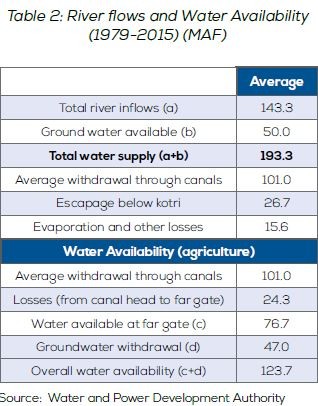
Pakistan has a precarious position given that, on the one hand, Indus Basin’s security is endangered owing to Indo-Pak water disputes and on the other hand, Pakistan depends solely on Indus Basin water supplies for its water, whereas other regional countries cover their water needs either from rainfall or multiple basins.
Pakistan’s water shortage is becoming more severe as India constructs more dams and barrages on the River Chenab and River Jhelum, violating IWT. Presently, Pakistan has a surface water of 153 MAF, and underground water resources of only 24 MAF, and Pakistan may face a water shortage of 33 MAF by the year, 2025.
Read More: Water is the New Gold: An Emerging Source of Global Conflicts
Another factor affecting water supplies is the varying precipitation and melting of snow on which river runoffs depend. Similarly, ambiguity about multi-year cyclic weather patterns also affects river flows.
As far as Pakistan is concerned, “these patterns, which are quite significant because they explain a huge gap between the minimum river inflow of 98.6 MAF (realized in 2001-02) and the maximum inflow of 186.8 MAF (in 1959-60).”
Furthermore, water security is also threatened by inefficient irrigation infrastructure and limited water storage capacity in Pakistan. Consequently, reliance on groundwater extraction, which “contributes 40 percent to total supplies at the farm gate”, becomes another obstacle for sustainable development Pakistan’s renewable freshwater resources are suffering from extensive demand pressures, which is also evident from low access to drinking water and sanitation facilities.
Read More: Politicisation of water resources in South Asia: Impending omens of war -I
Accordingly, Pakistan is categorized as being close to severe water scarcity with a per capita availability of 1017 cubic meters, by comparison, per capita water availability in India is 1,600 cubic meters.
This water stress is directly proportional to growing water demand because of the rising population, rapid urbanization, climate change, and water quality degradation. The World Resource Institute (WRI) Report states that “Pakistan is going to face a high level of water stress by 2020.”
Till the year 2030, “the ranking will worsen further to an extremely high level, thus pushing Pakistan to the list of top 33 countries under extreme water stress.” A study by Pakistan Counsel of Research on Pakistan’s water resources (PCRWR) divulged that “rapid depletion of groundwater may soon worsen the water crisis in Pakistan’s major cities, causing a drought-like situation.
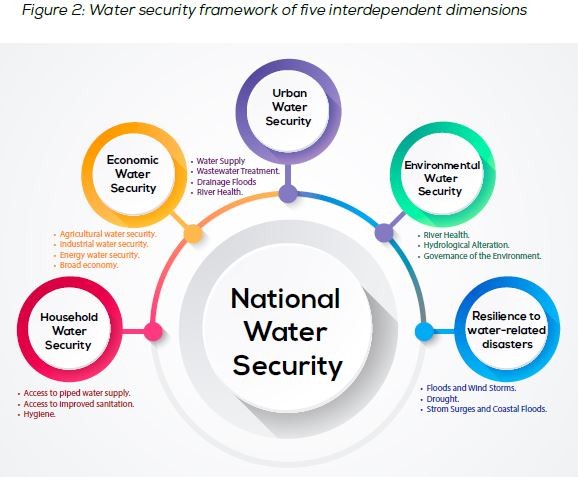
Such crisis needs to be managed on a war footing; otherwise, a large section of Pakistan’s population, especially those living in big cities, will be facing a severe shortage of water.” Pakistan only has water storage for 30 days that is threatening for a country whose water consumption rate is fourth in the world.
Read More: Politicisation of water resources in South Asia: Impending omens of war – II
This is extremely low in comparison with other countries, such as Egypt (700 days), the United States of America (900 days), and India (120 to 220 days).
Current Climate Change Situation in Pakistan
Impacts of climate change on Pakistan’s atmosphere are becoming visible. Investigations of temperature datasets demonstrate an increasing warming pattern all over Pakistan. Regional changes are altering general warming patterns of the lower Indus Basin.

Changing the South Asian Summer Monsoon (SASM) rainfall pattern will have significant impacts on freshwater resources management, agricultural production, and the region’s overall economy.
Future Climate Impacts on the Basin and Pakistan
Climate forecasts suggest Indus Basin’s temperature and changes in precipitation would keep on rising in the years ahead. As overflow from glaciers decidedly corresponds “to summer temperatures, higher summer temperatures are likely to prompt higher rates of spillover.”
As for changes in precipitation, climate models anticipate that precipitation levels will increase in many parts of Pakistan. An expansion in between yearly and intra-occasional inconstancy is additionally anticipated.
Read More: Climate Change and Mismanagement of water resources in Agriculture sector
These progressions point to a more serious danger of flooding amid the storm season in the coming decades. In the long haul, water security in the Indus Basin will be threatened with less snow cover in the Hindu Kush-Karakoram Himalaya (HKH) ranges.
Ranges of Impact
Many socio-economic sectors of Pakistan depend upon the timely and efficient water flow from Indus Basin. Subsequently, alteration in the water flow from Indus Basin will have socio-economic growth of Pakistan.
In this context, three sectors, in particular, energy, agriculture, and health are impacted by water insecurity in Pakistan. While these segments are particularly susceptible to changes in water accessibility, Pakistan’s rising levels of water demand and developing water insecurity per capita further affect them.
Implications on Water Demand
Over the previous five decades, water requests inside every one of Pakistan’s provinces have been increasing and going forward this pattern is expected to continue especially with the rise in population, unchecked urbanization, and increased economic growth.
Read More: Why Pakistan’s feudal class is not worried about the water crisis?
Evaluations show that “the total population of Pakistan is 207.8 million with an average growth rate of 2.4% from 1998 to 2017” and could reach 245 million individuals in 2030 and 309 million in 2050. The aggregate sustainable water accessibility in the nation is moderately dormant at 247 cubic kilometers.
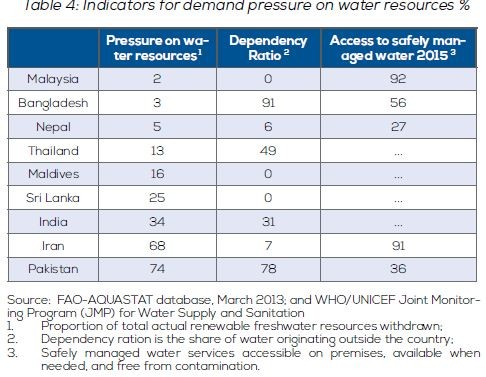
This increase in population and related water demand has prompted an unfaltering decrease in per capita water accessibility. Thirty-nine percent of Pakistanis lived in urban areas in 2015, this is expected to increase to 47 percent in 2030 and 58 percent by 2050.
Water use is on average almost 45 liters per capita per day, yet in urban regions; it is around 120 liters per capita per day. Water demand will rise by 15 cubic kilometers by 2050, and then add up to water demand around 195 cubics. kilometers.
Read More: Looming water crisis, economy at stake: WEF warns Pakistan
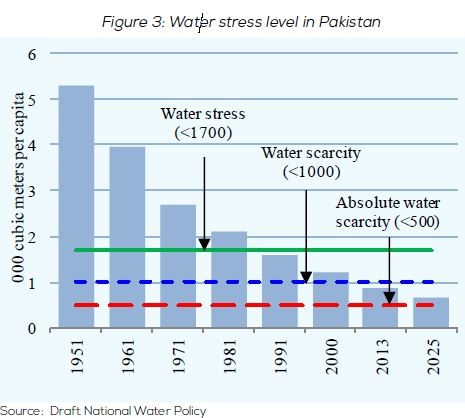
Furthermore, developments under the China-Pakistan Economic Corridor (CPEC), are also anticipated to environmentally change the situation, and add to water demand in increments to 220 cubic kilometers by 2050.
Implications on Energy Sector
Given its potential in hydroelectricity, Pakistan is encouraging private sector investments in hydroelectricity to make Pakistan energy secure and achieve required economic growth.
While add up to hydropower limit was “6,720 MW starting at 2010, the aggregate potential limit is around 60,000 MW. All of this potential lies in Khyber Pakhtunkhwa, Gilgit Baltistan, Punjab, and Azad Jammu and Kashmir”; 75 percent of all hydropower potential in Pakistan is contained in the Indus River Basin.
Read More: Pakistan’s water crisis: expensive and deadly
Furthermore, “under Pakistan’s Integrated Energy Plan 2009-2022, the legislature has commanded an expansion in hydropower creation to 17,392 MW by the year 2022-2023 at any cost”.
Given the ventures that are presently being executed (albeit, for the most part, few hydel ventures), the aggregate hydel limit can be relied upon to develop to 42,765 MW by 2030. Contingent upon the average life expectancy of recently developed dams, the loss of ice sheets and its potential effects on water streams in the Indus River could influence water supplies.
Implications on Agriculture Production
Pakistan’s agricultural growth and production rely on water from the Indus River. Land watered by the Indus Basin Irrigation System creates around 90 percent of Pakistan’s aggregate farming production.
Farming additionally produces around 22 percent of Pakistan’s GDP. Water demand in the agribusiness is anticipated to build significantly more than in different areas to meet the developing sustenance prerequisite needs of a growing populace.
Probable effects of climatic change to agriculture include decreases in the accessibility of water, a diminishing economic growth; lessened grain generation in southern Pakistan of up to 20 percent; and a potential decrease in domesticated animal production up to 30 percent.
Read More: Balochistan’s water-crisis: Tailored solutions before its too late
Climate change will disproportionally affect rural generation as well. In “Punjab and Sindh, constrained ability to store water could incur damages of around 20 to 25 percent of cultivable land, rendering it unfit for agribusiness.” Also, “it has been anticipated that a four °C increment in temperatures and 3 percent increase in precipitation by 2080 could bring about a misfortune in agrarian profitability of up to 13 percent.”
Comparable outcomes have been produced by suggesting that “more unfavorable change could possibly be in Sindh.” However, “in Pakistan’s northern lower regions, wheat, maize, and rice yields could increase because of longer and sultrier summer seasons.”
Implications on Health
Climate change is also deteriorating water quality that further results in water-borne diseases. Water quality in Pakistan is progressively being affected by ecological degradation and increasing water use.
Plus, there is a shortage of 10 million housing units in Pakistan, and the proliferation of slum communities within each of the major cities, as well as slumlike situations in rural areas that are being urbanized without standards and regulations, is a significant source of low water quality, affecting the health of many.
Read More: Grand Vision for Pakistan’s Water Future
Flooding events result in local nullahs flooding that affects vulnerable populations, such as slum dwellers. Therefore, climate change together with poor health conditions usually causes water-borne pathogens and sicknesses.
Conclusion and Recommendations
Water insecurity is a global problem. However, the issue exacerbates the increasing gap between water supply and demand, poor water-management practices, and other water resources unavailability.
At present, Pakistan is water-stressed, and the situation will further worsen due to internal management, along with being situated in a water-stressed region, where conflicts on water sharing can arise in the future.
Riparian states of the Indus Basin, such as Pakistan, are going to be adversely affected by insufficient water supply from the basin and may end up fighting for water resources. This scenario can be inferred owing to straightforward reasons.
Read More: Water war between Pakistan and Afghanistan?
The Indus River System is the socio-economic backbone of Pakistan, providing livelihoods to more than 70 percent of the population and accounting for 20 percent of the GDP.
Unfortunately, water security is being undermined by rapid population growth, climate change, lack of cooperation and diplomacy between riparian countries of South Asia, and the trust gap amongst Pakistan’s provinces.
As water has been essential for Pakistan due to its status as an agricultural nation and a prime benefactor for Pakistan’s economic growth, it has become an existential need for Pakistan.
That is why Pakistan-a water-stressed country- needs drastic steps to improve its water situation for sustainable development in the shape of a robust National Water Policy. The best way to meet the challenge of climate change is to build as many large and small water storages as possible.
Pakistan should also develop the capacity to store and regulate water in dams, barrages, and wetlands and around urban centers, creating a minimum of 18 Million Acre Feet (MAF) of storage to ensure water security.
Read More: Climate change and worsening water situation in Pakistan
As for water governance, there is a need to devise and implement provincial climate change strategies and define the action-oriented resolution of water problems. For this purpose, the mandate of the Pakistan Climate Change Act can be extended to water sector adaptation at local, provincial, and country levels.
To implement adaptation strategies, the establishment of provincial funds is a prerequisite. Climate financing – concerning the water sector adaptation projects could be a starting point. Pakistan can also encourage the private sector for Climate- Water Sector financing under CPEC projects. More specifically, the following recommendations may be considered for further research and deliberations:
- Mechanisms for water data collection have to be improved wherein increasing investment and capacity building of relevant implementation authorities are also required.
- Water governance; there is a need to devise and implement provincial climate change strategies and define the action-oriented resolution of water problems. For this purpose, the mandate of the Pakistan Climate Change Act can be extended to water sector adaptation at local, provincial, and country levels.
- To implement adaptation strategies, the establishment of provincial funds is a prerequisite. Climate financing – concerning the water sector adaptation projects could be a starting point.
- Better water management and smarter use can increase water productivity, land productivity, irrigation efficiency and mitigate the threat of water scarcity in Pakistan.
- Awareness campaigns regarding climate change and water scarcity at the local level will help respond to the growing water demand with rapid urbanization.
- Implementation of Integrated water resources management (IWRM) framework in its letter and spirit and installing gauging sites in the basin riparian countries’ basin will improve data collection for water and climate change research.
Adeel Mukhtar is Research Associate at Islamabad Policy Research Institute. He tweets at @mirz_adeel
The views expressed in this article are the author’s own and do not necessarily reflect the editorial policy of Global Village Space.


